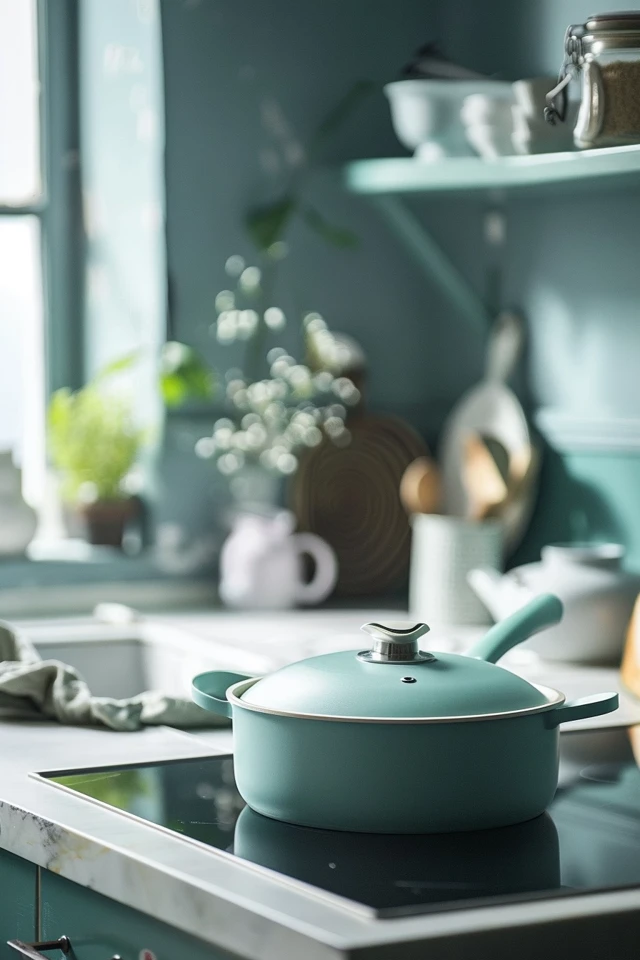Seasoning a ceramic pan is a crucial step to achieve non-stick cooking. While the ceramic coating itself is not inherently nonstick, seasoning creates a thin layer of oil that enhances the non-stick properties of the pan’s surface. By following the right steps, you can ensure that your ceramic pan remains in optimal condition for effortless cooking.
Key Takeaways:
- Seasoning a ceramic pan involves burning a thin layer of oil to create a non-stick coating on the ceramic surface.
- Wash the pan thoroughly to remove any residue before seasoning.
- Use oil with a high smoking point, such as avocado or sunflower oil.
- Heat the pan slowly until it smokes, then let it cool completely.
- Wipe away any excess oil after seasoning.
- Regularly season your ceramic pan to maintain its non-stick properties.
How to Season Ceramic Cookware: Step-By-Step Guide
The process of seasoning ceramic cookware involves several simple steps that can help you achieve a non-stick surface and enhance the longevity of your ceramic pan.
- Wash your ceramic pan: Start by thoroughly washing your ceramic pan to remove any food or burnt oil residue. This ensures a clean surface for the seasoning process.
- Add oil to the pan: Once the pan is clean and dry, add oil with a high smoking point, such as avocado oil or sunflower oil. This will serve as a coating to create a non-stick surface on your ceramic pan.
- Spread the oil evenly: Use a paper towel or a soft cloth to spread the oil evenly across the entire surface of the pan, including the sides and edges.
- Heat up the pan: Place the pan on the stovetop or in the oven and heat it slowly until the oil starts smoking. This process helps bond the oil to the ceramic surface, forming a protective layer.
- Let it cool: Once the pan reaches the smoking point, remove it from the heat source and let it cool down completely. This allows the oil to solidify and adhere to the ceramic surface.
- Wipe away excess oil: After the pan has cooled, use a clean paper towel or cloth to wipe away any excess oil. This ensures that the non-stick coating is smooth and even.

The frequency of seasoning your ceramic pan depends on how often you use it and the condition of the non-stick surface. It is recommended to season the pan periodically, especially when you notice food sticking or when the surface appears rugged and uneven.
By following this step-by-step guide, you can easily season your ceramic cookware and enjoy the benefits of non-stick cooking. A properly seasoned ceramic pan not only improves the cooking experience but also prolongs the lifespan of your cookware. So, take the time to season your ceramic pan and savor the joy of effortless cooking!
Tips for Maintaining Seasoned Ceramic Pans
To make your seasoned ceramic pans last longer, it is important to maintain them properly. The key to maintaining your ceramic pans is proper cleaning. Use a soft sponge and mild dish soap to clean your pans, ensuring you remove any food residue. Avoid using abrasive sponges or steel wool pads as they can scratch the non-stick coating, compromising its effectiveness.
Furthermore, it is highly recommended to avoid using metal utensils with your ceramic pans. Metal utensils can chip away at the nonstick and ceramic coating, causing damage and reducing the lifespan of your pans. Instead, opt for silicone or wooden utensils that are gentle on the ceramic surface.

Another important tip is to avoid stacking your ceramic nonstick pans. The friction between the pans when they are stacked can easily wear out the non-stick coating. If you have limited space and need to stack them, place a clean paper towel or dishcloth between the pans to provide a protective barrier.
In addition, it is crucial to cook at moderate temperatures when using ceramic pans. Excessively high temperatures can cause the non-stick characteristics to break down, reducing the effectiveness of the coating. Also, avoid using cooking oil sprays as they can leave a sticky residue on the pan’s surface, making it harder to clean and potentially causing food to stick.
Lastly, always hand-wash your ceramic dishes instead of using a dishwasher. Dishwasher detergents can be harsh and may damage the non-stick coating on your pans. It’s best to gently clean them with a soft sponge and mild dish soap to preserve their non-stick properties for longer.
By following these tips, you can maintain your seasoned ceramic pans properly and enjoy effortless non-stick cooking for an extended period.


